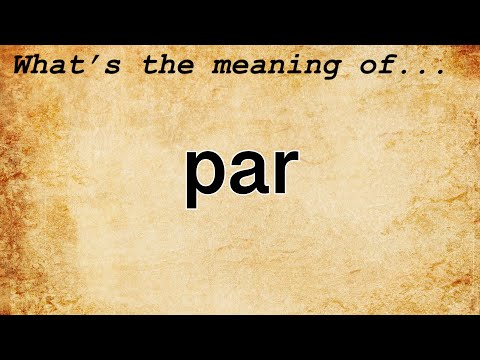Understanding Par Definition in Mortgage Context
In the realm of mortgages, the term ‘par’ might turn everything topsy-turvy if you’re not too careful. As it turns out, it’s not as daunting as it seems – not if you squash that fear with knowledge.
Firstly, allow me to peel back the layers of ‘par definition.’ By definition, ‘par’ symbolises an amount taken as an average or norm. In layman’s terms, it’s a standard, a benchmark if you will. Now, translating this into the context of the mortgage industry, ‘par’ is used to describe the face value of a loan or mortgage bond.
Here’s an interesting twist – a loan can be ‘at par,’ ‘above par,’ or ‘below par,’ all of which have rippling effects on both borrowers and lenders. When a loan is ‘at par,’ it’s sold at its face value. If a loan goes ‘above par,’ that’s a sign it’s selling for more than its face value. On the other hand, when we talk about ‘below par,’ the loan is selling for less than its face value. Not such a hard nut to crack now, is it?

Delving Deeper: Defining ‘On Par’
Now that we’re getting to grips with the basic premise, let’s dissect the term ‘on par’ further. To be ‘on par’ is to be equivalent or equal. In terms of mortgages, it means a loan is sold at exact face value; no more, no less . In other words, if you’ve got a $200,000 loan and it’s sold ‘on par,’ it’s dealt at exactly $200,000.
‘On par’ loans can have their ups and downs, their advantages, and drawbacks. For lenders, it’s a safe bet – there’s no risk of selling it for less than its value. However, they miss out on premium pricing, which is possible with ‘above par’ loans. For borrowers, an ‘on par’ loan is straightforward and uncomplicated, but the odds of negotiating the interest rate down are as slim as a rake.
Historically, there’s a treasure chest of scenarios showing how mortgage loans being ‘on par’ have sharpened or dented loan agreements. Case studies showcase how the minutiae of these definitions can have a butterfly effect on the final deal. Remember, understanding these intricacies can be the ace up your sleeve when you’re dancing the mortgage tango.

| Definition | Examples | Synonyms | Related Phrases/Idioms |
|---|---|---|---|
| An amount taken as an average or norm | Setting the ‘par’ for a city’s living standards based on average income and cost of living | Average, Norm | Up-to-par, on par |
| An accepted standard, typically of physical condition or health. | I’m not feeling up to ‘par’ today – expressing physical health isn’t as good as usual | Standard, Normal | Below par, above par |
| Equivalent, as good as | He may be an amateur, but his skills are on ‘par’ with professionals – indicating that skill or quality is as good as the accepted standard | Equal, Equivalent | On a par with |
| A disrespectful social act or comment | Your comment was a ‘par’, it was disrespectful – used primarily in British slang | Faux pas, Insult | You’ve been parred |
| A term used for balance in context of equality or equilibrium | There needs to be ‘par’ in responsibilities among team members | Balance, Equality, Equatability | Par in responsibilities |
Broadening Perspective: A Detailed Look at ‘Define Par’
Alright, let’s pull back a bit and wrap our minds around a broader term: ‘define par.’ This idiom is used commonly within the mortgage industry, entailing a deeper implication of ‘par.’
The concept of ‘define par,’ much like ‘on par,’ is linked closely to the idea of equality or even equilibrium. It addresses the value at which a security is traded without any additional premium or discount. In simpler terms, ‘define par’ spells out the situation when a loan sells for exactly the face value – no trimmings, no fluff.
To say that ‘define par’ is a vital mortgage term is an understatement. A plethora of industry experts declare the concept of ‘define par’ as one of the cornerstones of a successful mortgage strategy, showing the practical application of ‘define par’ is as varied as it is vast.

Navigating Uneven Ground: Below Par and Above Par Mortgages
Shifting gears, let’s explore the world of ‘below par’ and ‘above par’ mortgages. The roller coaster of mortgage rates can be a real ride if you don’t buckle up and understand what’s going on, folks.
When a loan is sold ‘below par,’ it’s like a sour deal in a fruit market – it’s sold for less than its face value. This can often leave lenders feeling as miffed as a shaven cat. Yet, for borrowers, it could mean lower interest rates and a better yield spread, making the total mortgage cost a bit more digestible.
Contrarily, when a loan sells ‘above par,’ it’s like striking gold for the lenders. They enjoy a premium on the face value, thus increasing profitability. For borrowers, though, this might mean higher interest rates knotted with higher yield spreads, hiking up the total mortgage cost in the long run. Like Kelly Mcgillis said in Top Gun, “There are no points for second place.” The power of these definitions could be the difference between landing a good deal or a raw one.

How Par Definition Influences Mortgage Decisions
Without a shadow of a doubt, understanding par definitions can be a springboard to making informed mortgage decisions. It’s not just about memorizing terms and meanings; it’s about playing your cards right.
Take Lucy, for instance. She understood what the term ‘par’ meant. More so, she recognized the implications of different par definitions, such as ‘on par’, ‘above par’ and ‘below par’. When Lucy walked into the negotiation room, she was armed not only with the facts but also had a firm grip on mortgage lingo. Alas! She was able to broker a more favourable deal – a loan ‘below par’ with low-interest rates.
Juxtapose Lucy’s case with Harry—poor soul. Harry was in the same boat as Lucy but lacked the knowledge of par definitions. Ugh! His decision cost him a pretty penny as he bagged a loan ‘above par,’ which resulted in a higher total mortgage cost. Clearly, a simple understanding of the par definitions can change the game.

The Future of Par Definition in 2023 and Beyond
As the mortgage industry evolves, so does the role of the par definition. The dynamics of par pricing continue to change, impacting rate decisions and reshaping the face of mortgage lending.
Industry experts are predicting new trends surrounding the use and interpretation of par definitions. Watch this space – you might be surprised at how the mortgage landscape will change in the coming years.

Deciphering Mortgage Jargons: Beyond Par Definition
Par definition does paint a jolly good hullabaloo for those in the mortgage game. However, there’s more to the tale. Other mortgage terms that borrowers and lenders alike should be familiar with include ‘absorption definition‘, ‘equal definition‘, ‘distress definition‘, to count a few.
It’s pivotal to understand how each term interplays with one another. For instance, knowing how ‘equal definition’ aligns with on ‘par definition’ can provide a holistic understanding of your mortgage contract. And trust me, it’s better to get the hang of this before you’ve signed on the dotted line.
Final Thoughts: Demystifying Par in the Mortgage Maze
In the final analysis, understanding the par in the mortgage maze is like finding your north star in the financial hemisphere. It might seem like a daunting task at first. But once you’ve cracked the code of mortgage jargon, it paves the way for a better and more informed financial journey.
Remember, it’s not just about ‘par definition.’ It’s about the weight it carries in the mortgage landscape. There lies an undeniable correlation between understanding this concept and brokering a favourable deal. So, good luck navigating the peaks and troughs of the mortgage world. You’ve got this!
What does by par mean?
“By par” is a term often thrown around in the financial world, but what does it actually mean? In simple terms, it’s just the face value or original value of a financial instrument like a bond or a share. So, if a bond that was initially sold for $100 is trading at par, it’s still worth that very same $100.
What does just a par mean?
“Just a par”, now this phrase is a bit puzzling, huh? It simply implies being average or the usual. Nothing over the top or extravagant. Much like a par score in golf, it means you’re hitting the expected mark, not underperforming nor outshining everyone else.
What is a par in slang?
Now, the term “par” surely has different shades in various contexts, right? In some street slang or casual banter, “par” often refers to a put-down or an insult. It’s like when your friend roasts you at a get together, boy, that’s a par!
What is a synonym for par?
You might be thinking, what’s another word for “par”? Well, off the top of my head, a great synonym would be “standard”. It conveys the same idea of meeting an average or expected level, like par does in various contexts.
Why do people say par?
You may be wondering, why on earth do people say “par”? Well, it’s a way of expressing whether something is normal, standard or expected. It’s a pretty handy word to have in the ole vocabulary to measure an outcome, whether in sports, finance, or just everyday chatter.
What does par 70 mean in golf?
Let’s be honest, we’re not all golf pros here. “Par 70” in golf simply means the total number of strokes a scratch golfer – that’s a really good player for those not in the know – is expected to make to complete a round or course, which, in this case, is 70.
How do you use par?
Using “par” can seem tricky at first, but it’s simpler than you might think. You can use it to talk about any standard or expectation. For example, you could say “His performance was on par with the best in the business”, suggesting that their performance met a high standard.
How do you use the word par?
Still puzzled about how to use “par”? Try thinking of it as a fun, versatile word you can toss around in sentences to denote an average level of something. Example, “Their service is right on par with my expectations,” and behold, you’ve nailed it!
Is par short for something?
You might be curious and wonder, is “par” short for something? In most cases, it’s not – it’s a standalone word. However, in the legal world, it stands for “purchase at retail”, a nifty abbreviation that only a lawyer could love.
What does go to par mean?
Now “go to par”, what does that even mean? In financial jargon, this phrase often refers to a financial instrument (like bonds or shares) returning to its original value. So if a bond that was sold for $100 goes to par, it’s back to being worth $100.
What is par in Oxford dictionary?
Let’s grab the trusty Oxford dictionary for this one. In Oxford speak, “par” is defined as “the standard or normal level, condition, or quantity”. Whether we’re talking golf scores or bond prices, par gives a benchmark about what’s usual or to be expected.



